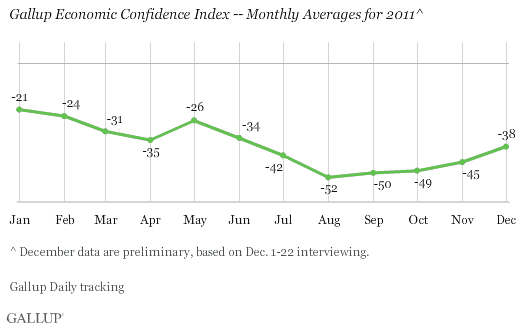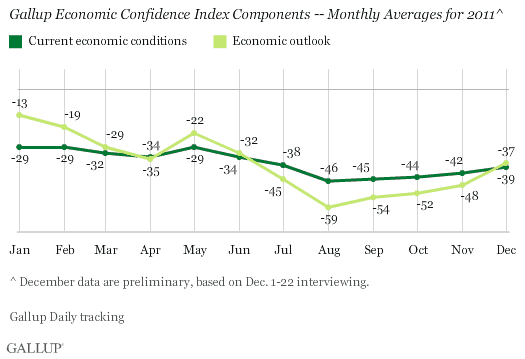PRINCETON, NJ -- The Gallup Economic Confidence Index has averaged -38 thus far in December, up from -45 in November -- putting December on track to be the most positive month for consumer attitudes since June. However, confidence remains depressed in comparison to the already weak levels seen from January through March.

For some additional perspective, the preliminary Economic Confidence Index reading of -38 is about 10 percentage points lower than what Gallup found in December of each of the past two years (-28 in 2010 and -27 in 2009), but is about 20 points higher than what it was in December 2008 (-59).
The Gallup Economic Confidence Index is an average of two components of consumers' psychology: Americans' ratings of current economic conditions and their perceptions of whether the economy is getting better or getting worse. The Index has a theoretical maximum of +100, obtained if all Americans say the economy is excellent or good and improving. The index could go as low as -100 if all Americans perceive the economy as poor and getting worse.
While both dimensions have improved in recent months, perceptions of the economy's direction have seen a particularly sharp increase, rising more than 20 points since August -- from -59 to -37. Over the same period, perceptions of current economic conditions have improved from -46 to -39.

Essentially, consumer attitudes are now just slightly worse than they were in June, prior to the Wall Street jitters over Europe's mounting debt crisis and the political drama about raising the debt ceiling that sent Americans' economic confidence tumbling.
Bottom Line
U.S. economic confidence has inched higher each month after descending to -52 in August. However, if Americans' confidence in the economy in the last week of December is as relatively positive as it was in the three weeks leading up to Christmas, in December it will post the largest monthly increase in economic confidence seen since May. With most of these gains coming from increased public optimism about the economy's direction, this may be a precursor to further gains at the start of 2012.
Gallup.com reports results from these indexes in daily, weekly, and monthly averages and in Gallup.com stories. Complete trend data are always available to view and export in the following charts:
Daily: Employment, Economic Confidence and Job Creation, Consumer Spending
Weekly: Employment, Economic Confidence, Job Creation, Consumer Spending
Read more about Gallup's economic measures.
View our economic release schedule.
Survey Methods
Results are based on telephone interviews conducted as part of Gallup Daily tracking Dec. 1-22, 2011 (with no interviewing Dec. 15), with a random sample of 10,397 adults, aged 18 and older, living in all 50 U.S. states and the District of Columbia.
For results based on the total sample of national adults, one can say with 95% confidence that the maximum margin of sampling error is ±1 percentage point.
Interviews are conducted with respondents on landline telephones and cellular phones, with interviews conducted in Spanish for respondents who are primarily Spanish-speaking. Each sample includes a minimum quota of 400 cell phone respondents and 600 landline respondents per 1,000 national adults, with additional minimum quotas among landline respondents by region. Landline telephone numbers are chosen at random among listed telephone numbers. Cell phone numbers are selected using random-digit-dial methods. Landline respondents are chosen at random within each household on the basis of which member had the most recent birthday.
Samples are weighted by gender, age, race, Hispanic ethnicity, education, region, adults in the household, and phone status (cell phone only/landline only/both, cell phone mostly, and having an unlisted landline number). Demographic weighting targets are based on the March 2010 Current Population Survey figures for the aged 18 and older non-institutionalized population living in U.S. telephone households. All reported margins of sampling error include the computed design effects for weighting and sample design.
The questions reported here were asked of a random half-sample of respondents for 21 nights on the Gallup Daily tracking survey.
In addition to sampling error, question wording and practical difficulties in conducting surveys can introduce error or bias into the findings of public opinion polls.
For more details on Gallup's polling methodology, visit www.gallup.com.
